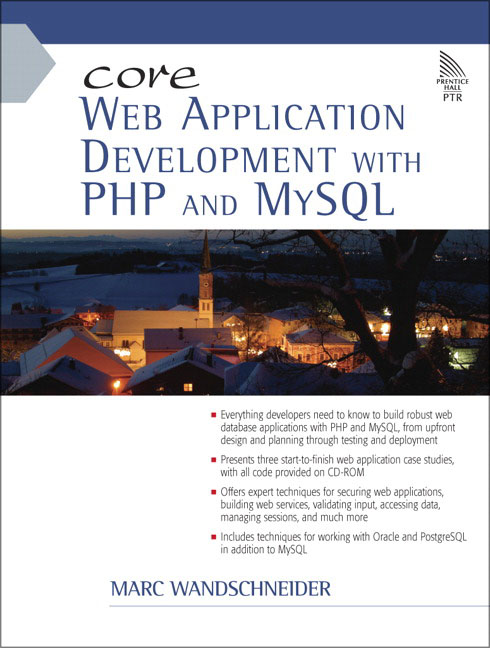Core Web Application Development with PHP and MySQL(英文版CHM)

OverView
The programmers guide to building robust web applications with PHP and MySQL
This is a comprehensive, practical guide for programmers who want to develop production-quality, database-enabled web applications with PHP and MySQL. Long-time developer Marc Wandschneider systematically addresses the entire process: not only coding, but also upfront application, user interface and database design, PLUS security, testing, and more.
Youll walk through building three applications from start to finish: a calendaring system, a weblog engine, and an e-commerce store. Along the way, youll master essential strategies for creating robust web database applications and learn how to avoid the common pitfalls that trip up many developers moving to PHP and MySQL.
Starts with a complete primer on PHP for developersincluding coverage of code organization, reuse, and object-oriented PHP
Contains detailed treatments of data access, including transactions, foreign keys, and indexes
Presents powerful data validation techniques utilizing PHP regular expressions
Walks through planning web applications, including user interfaces and user management
Offers systematic guidance on securing web applications from end to end
Covers a wide range of implementation issuesincluding internationalization, error handling, data validation, debugging, session management, and deployment
Includes detailed chapters on XML, XML-based web services, and the PEAR framework for reusable PHP components
Shows how to work with the Oracle and PostgreSQL databases
目录:
Copyright
PRENTICE HALL PTR CORE SERIES
Introduction
Target Audience
About PHP
Layout
Before You Begin
Acknowledgments
In Closing
Part I. The Basics of PHP
Chapter 1. Getting Started with PHP
Your First PHP Programs
Entering PHP Scripts
How to Store Data
Entering Basic Types in PHP
Some Very Useful Functions
Summary
Chapter 2. The PHP Language
More on Entering Strings
More on Data Types
Type Conversions
Variables and Constants
Expressions and Operators
Control Structures
Summary
Chapter 3. Code Organization and Reuse
Basic Code Reuse: Functions
Intermediate Code Reuse: Using and Including Files
Summary
Chapter 4. Object-Oriented Programming
Moving Beyond Libraries
Object-Oriented Programming
Extending Objects
Other Features
Summary
Chapter 5. Working with Arrays
Arrays Revisited
Iterating Over Elements in an Array
Multi-Dimensional Arrays
Operations on Arrays
Summary
Chapter 6. Strings and Characters of the World
Strings and PHP
Character Sets and Unicode
Making Sense of It All in PHP
Configuring PHP for Unicode
Operating on Strings
Summary
Chapter 7. Interacting with the Server: Forms
An Example of Forms
Working with HTML Forms
Working with the Server
Redirecting the User
Summary
Part II. Database Basics
Chapter 8. Introduction to Databases
What Are We Talking About?
Motivations for Using a DBMS
Major Database Servers
How to Select a Database Server
Our Choice
Common Interfaces
Summary
Chapter 9. Designing and Creating Your Database
What to Put into the Database
Organizing Your Data
An Introduction to SQL
Creating Databases
Setting User Permissions
Creating Tables
Deleting Tables and Databases
Summary
Chapter 10. Using Databases: Storing and Retrieving Data
Before We Begin
Inserting Data into Our Tables
Retrieving Data from Tables
Modifying Data in Your Tables
Deleting Data from Tables
Summary
Chapter 11. Using Databases: Advanced Data Access
Transactions
More Advanced Queries
Modifying Table Schemas
Summary
Chapter 12. PHP and Data Access
Getting Ready
Connecting and Authenticating
Executing Queries
Queries a Go-Go
Old-School Interfaces
Summary
Part III. Planning Web Applications
Chapter 13. Web Applications and the Internet
A Closer Look at the World Wide Web
Designing Web Applications
Summary
Chapter 14. Implementing a User Interface
User Interface Considerations
Implementing Your User Interface
Summary
Chapter 15. User Management
How Users Connect to Our Application
Visitors Versus Known Users
Validating Users
Summary
Chapter 16. Securing Your Web Applications: Planning and Code Security
Strategies for Dealing with Security
Identifying the Threats
Securing Your Code
Summary
Chapter 17. Securing Your Web Applications: Software and Hardware Security
Securing Your Web Server and PHP
Secure Sockets Layer (SSL)
Database Security
Protecting the Network
Computer and Operating System Security
Disaster Planning
Summary
Part IV. Implementing Your Web Application
Chapter 18. Error Handling and Debugging
How Errors Are Born
How PHP Manages Errors
Exceptions
Debugging
Summary
Chapter 19. Cookies and Sessions
Cookies: Tasty and Useful
Sessions
Session Security
Summary
Chapter 20. User Authentication
Planning for Members
Web Server-Provided Authentication
Implementing Our Own Authentication
Summary
Chapter 21. Advanced Output and Output Buffering
Globalization and Locales
Formatted Output
Output Buffering
Summary
Chapter 22. Data Validation with Regular Expressions
Using Regular Expressions
Data Validation with Regular Expressions
Other Regular Expression Functions
Summary
Chapter 23. XML and XHTML
XML
Working with XML in PHP
XHTML
Summary
Chapter 24. Files and Directories
Accessing Files
Accessing Directories
Security Considerations
Summary
Chapter 25. File Uploading
Uploading User Files
A File-Uploading Example
Security Considerations
Summary
Chapter 26. Working with Dates and Times
Sources of Dates and Times
Dates and Times in PHP
More Dates and Times in Database Servers
Summary
Chapter 27. XML Web Services and SOAP
XML Web Services
How Web Services Work
Using Web Services in PHP
Sample: Working with the Google APIs
Summary
Chapter 28. Using PEAR
Introduction to PEAR
Installation and Configuration
Basic Commands
Example: Using the Date Class
Summary
Chapter 29. Development and Deployment
Coding Standards
Source Code Control
Testing
Deployment
Summary
Part V. Sample Projects and Further Ideas
Chapter 30. Strategies for Successful Web Applications
Singleton Objects
Session Management
A Holistic Approach to Error Handling
Database Connection Management
PHP Configuration Settings
Summary
Chapter 31. An Appointment Manager
Overview
Installing and Running the Sample
Structure and Page Progression
Code Walkthrough
Suggestions/Exercises
Summary
Chapter 32. A Blogging Engine
Overview
Installing and Running the Sample
Structure and Page Progression
Code Walkthrough
Suggestions/Exercises
Summary
Chapter 33. An Ecommerce Application
Overview
Installing and Running the Sample
Structure and Page Progression
Code Walkthrough
Payment Processing
Suggestions/Exercises
Summary
Part VI. Appendixes
Appendix A. Installation/Configuration
Installation
Configuration
Summary
Appendix B. Database Function Equivalents
Working with Databases
Data Description and Creation
Other Functions and Interesting Notes
Summary
Appendix C. Recommended Reading
Download:Core Web Application Development with PHP and MySQL(英文版CHM)